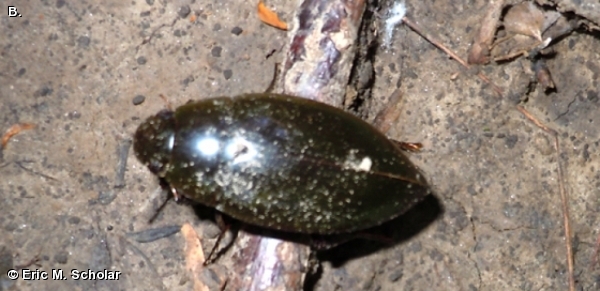
This beetle is about 1 ½ inches long. It is smooth and shiny, black and sometimes brown or even yellow. The body is oval or elliptic. It is convex at the top and usually flat below. It has a keel like spine running down its undersides. The antenna is short or concealed. This beetle was identified to genus with the help of experts at Bugguide.net.
Larvae and adults of most members of this family are aquatic or semiaquatic. It is believed to be fairly common at Fontenelle Forest. They live in quiet pools or quiet areas of lakes and streams with abundant vegetation.On summer nights these insects often leave water and fly about, drawn to artificial lights. Photo B was taken on Chickadee trail in late June in the morning.
These beetles eat the decaying remains of aquatic animals or small live animals. Members of the genus Hydrophilus are the largest of the water scavenger beetles. Most species of water scavenger beetles come up for air head first unlike the similar predaceous diving beetles which come up tail first. The name water scavenger beetles is not an accurate description of their habit. With rare exceptions, the larvae are predatory while the adults may be vegetarians or predators in addition to scavenging. Many members of this family are able to produce sounds.
Disclaimer: The content of NatureSearch is provided by dedicated volunteer Naturalists of Fontenelle Forest who strive to provide the most accurate information available. Contributors of the images retain their copyrights. The point of contact for this page is: Eric Scholar.

